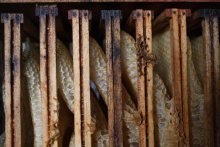More wonky comb
Hive A has delivered another super of honey. Unfortunately it is crooked and cross-combed.
The bees built the comb relatively quickly. I'm not certain why it isn't straight. Strong nectar flows induce the bees to build on several frames at once and I think this encourages straight comb.
There are a couple of options for extracting the honey. It can be cut out into plastic boxes or pressed using an apple press. Neither option returns reusable comb which is disappointing.
- Read more about More wonky comb
- Log in or register to post comments
